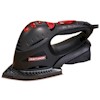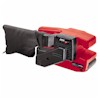How to Choose a Power Sander
Anyone who has tried to refinish a piece of furniture by hand knows that sanding even a small area takes a great deal of energy. This job can be transformed from an overwhelming chore into a manageable task by relying on the right power sander. There are many types of sanders, and the right one depends upon the job.
 |
 |
 |
 |
Shown above (left to right), a Craftsman detail sander, a Black and Decker orbital sander, a Porter Cable random orbit sander, a Skil belt sander |
|||
Types
- Detail Sander - is a light hand-held sander with a small pad for sanding where other power sanders can't, such as the inside corners of a box or uneven surfaces. Usually used for finishing sanding.
- Orbital Sander - is a small sander, they come in 2 sizes either palm size to fit ¼ sheet of sandpaper or large to fit ½ of a sheet of sandpaper. Orbital sanders rotate the paper quickly around one center point. Orbital sanders don't remove a lot of material and may leave a circular pattern on the material.
- Random Orbit Sanders - is a small sander that orbits and spins the sandpaper. This motion is more aggressive in removing material than an orbital sander and is less likely to leave circular marks.
- Belt Sanders - are large sanders that rotate a sanding belt that is stretched between two rollers. Belt sanders are ideal for removing large amounts of materials (e.g. paint, varnish, wood) over large areas. Belt sanders will leave a large scratch pattern in line with the direction of the rotating belt.
Attributes
- Dust Collection - for sanders that remove a large amount of material (random-orbit and belt) a dust collection bag or vacuum hose attachment is ideal.
- Size - All sanders come in many different size ranges. Choose the size that is appropriate for your average job. A sander that is too large will be harder to maneuver.
- Variable Speed - Belt sanders may have switches to adjust the belt speeds. This is feature can make the sander more versatile and lower the likelihood of damaging the material.
- Overall Design - Look at the location of the power cord, will it get in the way? How does the handle feel, it is comfortable? Pick up the sander. Is it well balanced?
How to Choose
- Determine the type of sander that is ideal for the type of work you are doing.
- Compare models based on size, overall design and price.
